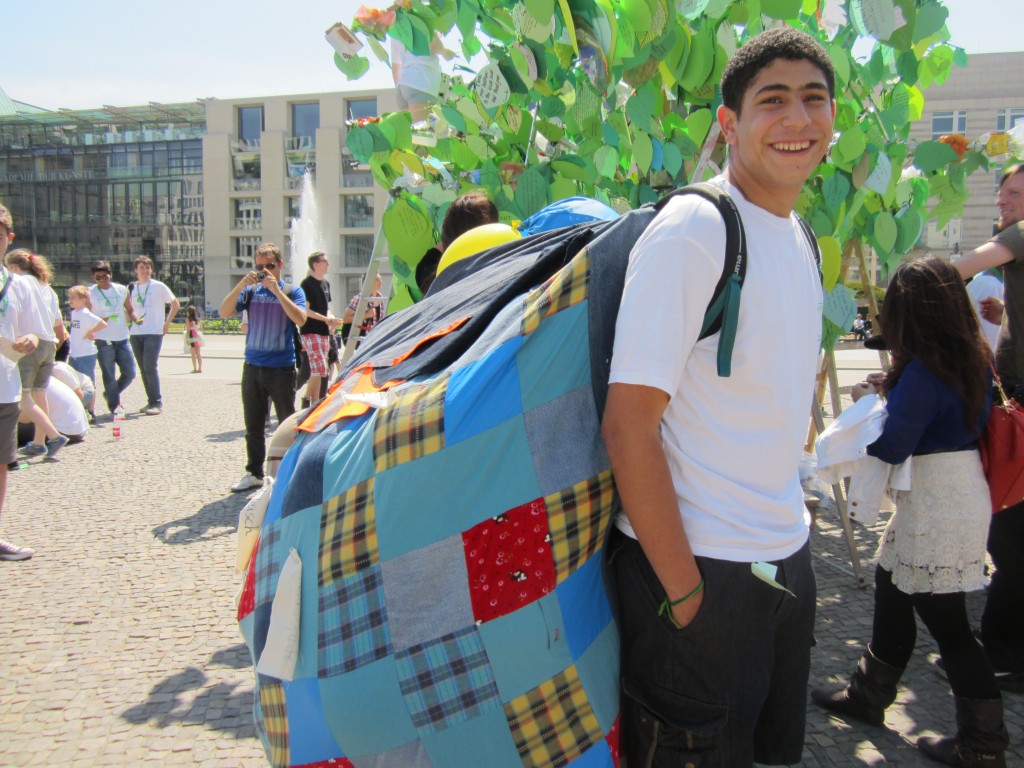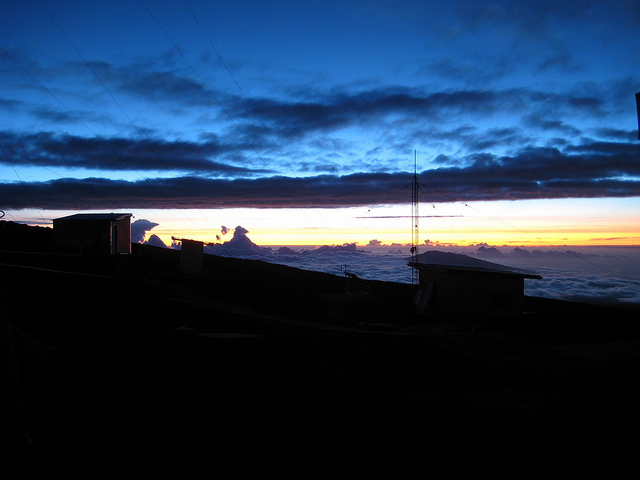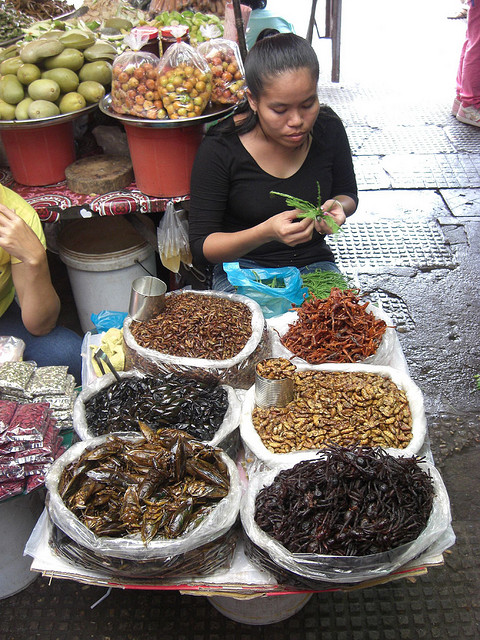Eat (more) insects!
Ever wondered what you could do to fight climate change, but never came up with a proper solution? A quiet common way is to switch to a vegetarian diet, as meat production accounts for about 30 per cent of greenhouse gas emissions. If you can’t do without your daily portion of proteins (aka meat) – here might be a convenient idea: Eat more insects! This is not a suggestion of some weird person being anxious about animals with too many legs and wants them to go extinct. It’s a seriously meant proposal from the UN to feed the booming population all over the world.
If a simple recommendation is not good enough for you, but you need some convincing numbers- the New Scientist has put them down:
To produce 1 kilogram of beef, for example, you need 10 kg of feed, whereas 1 kg of crickets requires just 1.7 kg. What’s more, 80 per cent of a cricket is edible compared with just 40 per cent of a cow.
In consequence, much less land would be needed to grow food for our food (as insects could even grow on kinds of waste) – we would get more food from the same amount of grain and would thereby cut pollution.
This kind of diet is already familiar in some parts of the world, yet the most consumed are beetles, ants and bees. In total 1,900 insects have been identified to be suitable for human diet.
But for lots of people it is quite unthinkable to take a bite. What’s your opinion: Is the argument of sustainability strong enough to change people’s minds?
Jane Goodall: 300 days on the road for the cause
Meeting Jane Goodall, British primatologist and avid environmental activist, is an honour. Global Ideas took the opportunity to talk with the world’s foremost expert on chimpanzees during a film screening in Brussels. The documentary Love MEATender focuses on earth’s growing hunger for more meat and the price we already have to pay for the excessive consumption.
A lot of people are already aware of the situation we are in, Goodall says. But that does not automaticly change something:
GI Jane Goodall What has to be done from DW_Global Ideas on Vimeo.
One of today’s main problems is that earth’s population is growing fast and with it the number of people who want to consume meat, Goodall adds. As the middle classes in the developing world are rising up, they want to have the same standards of living as the industrialized countries have. “Which is of course understandable.” But the planet is not growing, so it won’t be able to support this lifestyle much longer.
GI Jane Goodall more meat more problem from DW_Global Ideas on Vimeo.
For Jan Goodall the newest generations are the key to a solution. Her organization, the Jane Goodall Institute, runs an initiative called “Roots and Shoots program,” with the goal to “provide young people with the knowledge, tools and inspiration to improve the environment and the quality of life for people and animals,” as the program’s website says. “We need to train a new generation to be better stewards than we have been,” she adds. Otherwise there would be absolutly no point:
GI Jane Goodall important young people from DW_Global Ideas on Vimeo.
A Song, a Dance and Spots on the Fight Against Climate Change
 Yesterday, the colossal efforts each and every one of us put in the project came to fruition as the pinnacle of our project, the 1st world youth sustainability summit, came to be.
Yesterday, the colossal efforts each and every one of us put in the project came to fruition as the pinnacle of our project, the 1st world youth sustainability summit, came to be.
The event, many of whose attendees were project managers and leading figures in their respective fields, were pleasantly surprised as the youthinkgreen teams that took part in the gala showed discipline, determination and that they were not to be discouraged by the sheer size and importance of the event at hand.
The program, whose highlights were the youthinkgreen rendition of the song ,,Mut zum Handeln” (courage to act), the various student-produced environmentally oriented spots, and the Indian dance showed the unique inter-cultural connection between the various members of the Youthinkgreen.
The excitement at the event rubbed off on each and every one of our guests, with many of them on the verge of euphoria. We were standing hand-in-hand with people whose success has come to be known on every continent of the planet and watched in amazement as they relaxed and spoke to us as peers, not as minors, as friends not as climate change fighters.
All in all, to simply call our summit a success would be an understatement. The Allianz Forum will forever in our hearts be remembered as the place where we graduated into adults, supported along our journey by the constant recognition we received throughout the process.
Written by Mourad Farahat, youthinkgreen Kairo
Handing over the „Tree of Hope“
 The „Tree of Hope“ had a long and fruitful journey. First we planet it at the climate summit in Doha in December 2012. And now it grew at the 1st World Youth Sustainability Summit 2013 in Berlin. The tree is actually not a real tree. It’s trunk is made from garbage and the crown from green paper leafs filled with the wishes, demands and ideas of people from all over the world.
The „Tree of Hope“ had a long and fruitful journey. First we planet it at the climate summit in Doha in December 2012. And now it grew at the 1st World Youth Sustainability Summit 2013 in Berlin. The tree is actually not a real tree. It’s trunk is made from garbage and the crown from green paper leafs filled with the wishes, demands and ideas of people from all over the world.
It’s a beautiful and complex tree, meant to be a demand against mankinds extravagantly and unecological lifestyle. People should see the tree, read the leafs and think about their own daily routines. All 160 participants of the Youth Sustainability Summit collected the wishes and demands from friends and siblings in the 31 countries they call home. The tree grew upto 4 meters yesterday at the Brandenburg Gate in the centre of Berlin. And it grew more leafs as citizens and tourists also started to write on leafs.
 Besides the „Tree of Hope“ we used a 10qm blanket to illustrate the ecological foot- and hand-print everybody has. The foot-print depends on the way people live and how they consume things. The hand-print shows that it’s possible to fight against climate change. So we asked people to leave a colourfull print of feed and hands on the white blanket. The action was a success, it ended with a gala at the Allianzforum (Read the post by Mourad Farahat) where a nice breeze shook the leafs of the trees.
Besides the „Tree of Hope“ we used a 10qm blanket to illustrate the ecological foot- and hand-print everybody has. The foot-print depends on the way people live and how they consume things. The hand-print shows that it’s possible to fight against climate change. So we asked people to leave a colourfull print of feed and hands on the white blanket. The action was a success, it ended with a gala at the Allianzforum (Read the post by Mourad Farahat) where a nice breeze shook the leafs of the trees.
The leafs are filled with all kinds of demands, as you can see on the pictures. The ideas and wishes very much depend on where the writer comes from. You can imagine that a person from a developing countries shares quite different hopes as someone from a industrialized country.
We hope that all our wishes and demands will come true. That’s more than important to leave our children and grandchildren a world that is worth living. The way we live today destroys the future. I personally want to live in a world where nature has a more important role again and not only profit. I wish for more green spaces in cities, more room for bicycles and children to play. The „Tree of Hope“ is now in the hands of the German Environmental Minister Peter Altmaier. We hope for results.
Written by Anke Britta Schmidt, youthinkgreen Osnabrück /ke
Live like millions of years ago?

CO2 levels are measured on Mauna Loa volcano as the air is of very good (clear) quality up here (Photo: LCDR Eric Johnson, NOAA Corps)
You might not have realized it, but last Friday something quite historical happened: For the first time since the Pliocene (about five to three million years ago) CO2 concentration in the atmosphere crossed the 400 parts-per-million limit. The last time that much carbon dioxide was in the atmosphere, the Arctic was ice-free, the Sahara desert was a savanna and the sea level was 40 meters above today’s level.

NOAA’s observatories on dead Mauna Loa volcano, Hawaii, where atmospheric CO2 levels are monitored (CC BY SA 2.0: sharloch)
Measuring this carbon level is kind of a family business: More than 50 years ago, Charles Keeling started measurements on the dead Mauna Loa volcano, where air quality is very good. Back then, in 1958, CO2 concentration was around 315 ppm – compared to 280 ppm on preindustrial level. Today, his son Ralph Keeling continues the measurements.
The overall trend is increasing, though CO2 levels fluctuate periodically from winter to summer season, when plants naturally fix more carbon dioxide due to leaf growth. Scientists attribute this overall increase to anthropogenic CO2 emissions – mainly from burning fossil fuels.
Within the last ten years, CO2 concentration has risen by two ppm per year. If the world continues emitting carbon at this pace, the next important threshold is not far away (german link). CO2 concentration may not rise upon 445 ppm CO2 (445 molecules of carbon dioxide in one million molecules) if the two degree target is to be met, scientists of the Intergovernmental Panel on Climate Change (IPCC) say.










Feedback